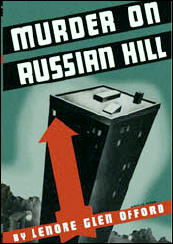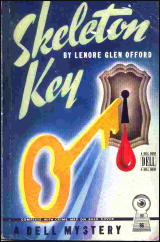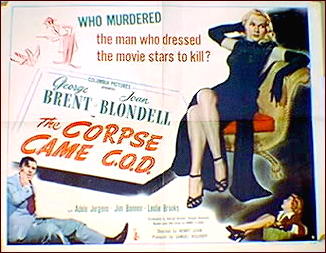August 2010
Monthly Archive
Wed 18 Aug 2010
THE BACKWARD REVIEWER
William F. Deeck
LENORE GLEN OFFORD – The Smiling Tiger. Duell Sloan & Pearce, hardcover, 1949. Hardcover reprint: Unicorn Mystery Book Club, December 1949. Paperback: Harlequin #159, Canada, 1952.
Although Todd McKinnon, who writes fictional short stories based on true cases, is having a writing slump, he is not interested in the tale presented to him by Hugh Hartlein. According to Hartlein, someone in Beyond-Truth, a cult opposed to any marriage that will produce children since the world is shortly to end, is bumping off its members who disobey that tenet.
Since some of the bumpees are Hildegarde Latham, Harriet Withers, and Grace Vane, McKinnon naturally is not duped.
Still he does take an interest in the leader of the cult. When Hartlein either commits suicide or is murdered by means of an inhaler containing crystalline cyanide, McKinnon gets somewhat involved. Later, after his wife, Georgine, is threatened, he takes the whole matter very seriously.
Another fine novel by Offord.
— From The MYSTERY FANcier, Vol. 11, No. 2, Spring 1989.
Bio-Bibliographic Data: Besides being a mystery writer, although not a prolific one, Lenore Glen Offord (1905-1991) was, I have discovered online, the long time mystery critic for the San Francisco Chronicle (1950-1982). She and the newspaper received the Mystery Writers of America Edgar award for best criticism in 1952.
Mike Grost has a lengthy commentary of several of her books on his Classic Mystery and Detection website. (He has placed her in the Mary Roberts Rinehart school of mystery fiction.)
Crime Novels: [Taken from the Revised Crime Fiction IV, by Allen J. Hubin]
# Murder on Russian Hill (n.) Macrae-Smith 1938 [Bill Hastings; Coco Hastings; San Francisco, CA]
# The 9 Dark Hours (n.) Duell 1941 [San Francisco, CA]
# Clues to Burn (n.) Duell 1942 [Bill Hastings; Coco Hastings; Idaho]
# Skeleton Key (n.) Duell 1943 [Todd McKinnon; San Francisco, CA]
# The Glass Mask (n.) Duell 1944 [Todd McKinnon; California]
# My True Love Lies (n.) Duell 1947 [San Francisco, CA]
# The Smiling Tiger (n.) Duell 1949 [Todd McKinnon; California]
# Walking Shadow (n.) Simon 1959 [Todd McKinnon; Oregon; Theatre]
Tue 17 Aug 2010
HERBERT FLOWERDEW – The Villa Mystery. Brentano’s, US, hardcover, 1912. First published in the UK: Stanley Paul, 1912. Serialized in The Cavalier, May 24 through June 21 1913. Also available online here and in various POD editions.
Before I discovered this book online and in various Print on Demand editions, I saw the title and author in this blog’s recent checklist of “Serials from Argosy Published As Books†and found a copy of the Brentano’s hardcover edition without too much difficulty. For less than twenty dollars in fact, which is one heck of a lot cheaper than finding a complete set of the five issues of The Cavalier which it appeared in.
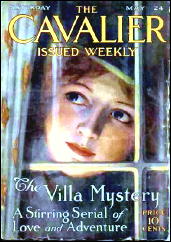
Of course, it does me no good to brag about this, not when you can read it online for free.
But should you? Can an obscure mystery or detective novel written in 1912 be worth the time and effort? My answer’s yes, given certain conditions, and I’m about to tell you why.
The story’s definitely an old-fashioned one – how could it not be? – and if you have an allergy to old-fashioned stories, you might as well stop reading this review right now. It begins with a young girl, totally destitute, making her way to a former friend of her dead father, a wealthy man who has refused to repay a loan.
But now that she has found the IOU, which had gone missing, she hopes to persuade him to repay his debt — but he refuses to listen to her, requiring her to return in the morning. He has no time to listen to her now. She leaves, but then returns to watch through the window of the study where she saw him earlier before entering once again, leaving the IOU and making off with a suitcase of money she has decided is rightfully hers.
In making her way back to the train station, however, she is accosted by one man and rescued by another. In the way that the world worked back in 1912, the latter is the stepson of the man whose debt to Elsa Armandy has been repaid in such an unorthodox fashion.
In another of the ways that the world worked back in 1912, Nehemiah Grayle is soon found dead, possibly a suicide (or so the butler claims) but more probably not. Compounding Esmond Hare’s deepening dilemma, for he believes the girl’s story (and she is most attractive) is that to remove her from suspicion means incriminating his own mother, now estranged from the dead man.
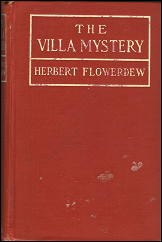
There is a local detective in charge of the case, but it is on Hare’s shoulders that solving the crime falls. But this is a story of romance as much as it is one of detective work, with much missing of connections as the characters move here and there and do not stay where they are supposed to stay, mostly because of revelations and stories not quite believed or not told in timely enough fashion.
And all the while staying out of the hands of the police, especially Elsa, but Esmond also, who fears he may say and reveal too much if he is questioned further.
Delicious, I say. They don’t write stories like this very much any more. But what’s even better is that there really are some even more delightful twists and turns in the detective side of things, including a final explanation which is really quite clever, almost as clever as one found in the best of the Golden Age of Detective stories.
It’s just a little awkward in the telling, I have to confess, and there are some even clumsier aspects of the clues and what the characters make of them earlier on, in their naively old-fashioned way, so it’s with these caveats that I do recommend you read this one.
Bio-Bibliographic Notes: There are 16 books listed for the author in the Revised Crime Fiction IV, by Allen J. Hubin, but nine of them are indicated with a hyphen as being only marginally criminous.
Herbert Flowerdew died in 1917 at the age of only 51. If he’d lived longer, perhaps he’d have taken this book as a stepping stone to a more significant mystery writing career, but that alas, we’ll never know.
Tue 17 Aug 2010
THE CORPSE CAME C.O.D. Columbia Pictures, 1947. George Brent, Joan Blondell, Adele Jergens, Jim Bannon, Leslie Brooks, John Berks, Grant Mitchell, Marvin Miller, Una O’Connor. Screenplay by George Bricker and Dwight V. Babcock, based on the novel by Jimmy Starr (1944). Directed by Henry Levin.
“Listen Joseph, I like you, even though you have an eye for two-headed blondes.”
— Reporter Rosemary Durant (Joan Blondell) to fellow reporter Joe Medford (George Brent).
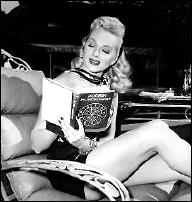
When Hollywood jewelry and dress designer Hector Rose is murdered (shot at the studio, the sound covered up by a prison escape being filmed nearby), his body is shipped C.O.D. to the home of movie star Mona Harrison (Adele Jergens) whose numerological charts predicted a bad day, as she tells her butler, Fields.
[ It’s too small for you make it out otherwise, but that’s a book on numerology that she’s reading over there on the right. Trust me. — Steve.]
She also calls on wanna-be boyfriend Joe Medford (George Brent), a fast talking newspaper man who isn’t above playing fast and loose with the facts to get a scoop.
Joe calls in cop Lt. Wilson (Jim Bannon), who hangs around the studios, hoping the apparently starstruck detective will give Mona a break, while at the same time keeping some facts from him, like the dress fabric he saw Mona take from the packing case that contained Hector’s body.
Back at Palisades Studio Joe finds things complicated by fellow reporter Rosemary Durant (Joan Blondell) and a lot of people with something to hide.
Between flirting with every woman who crosses his path but Rosemary, Joe heads for Hector Rose’s home, still two steps ahead of the police, where he tussles with someone who leaves him unconscious and with Rose’s unconscious business manager on his hands just as Rosemary shows up.
Jimmy Starr who featured Joe Medford as a reporter sleuth in two other slightly hard-boiled screwball detective novels (Three Short Biers, 1945; Heads You Lose, 1950) was a Hollywood reporter (he’s even mentioned in the film’s opening, along with Heda Hopper and Louella Parsons).
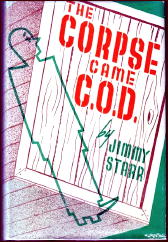
The screenplay is co-written by Black Mask alumnus Dwight V. Babcock (Homicide Hannah), with direction by studio stalwart Henry Levin.
Joe spots Mona with Rudy Frasso (Marvin Miller), a tough guy who is “always around the clubs,” and who threatens Joe if he involves Mona. Meanwhile Joe is called back to the studio by studio head Mitchell Edwards (Grant Mitchell) where Rosemary is already prowling around in the dark.
Hector Rose was importing something from New York, maybe something worth dying for, and Joe and Rosemary both soon find themselves in the dark among the bolts of cloth in the studio costume department with someone with a gun looking for it. At which point Joe stumbles on yet another murder — this time of a studio executive, the Director of Publicity.
This is programmer fare, but with an attractive and capable cast. The humor is a bit forced at time, and Brent isn’t at his best (to see him handle this same kind of material much better, see Front Page Woman, with Bette Davis as his newspaper rival), but the film is still fun and moves quickly, and he gives a perfectly good performance.
It’s no great discovery, but well worth a little time and fun to watch the pros at work, especially Blondell, who brings what energy the film has to her rivalry/romance with Brent.
Rosemary: Don’t call me baby.
Joe: Alright, Butch.
Mildly screwball — it never quite rises to the occasion, but strays near it once or twice — and pleasant, the film is worth a small investment of your time as a minor but entertaining example of the comedy-
mystery form.
Joe gets clobbered (again) at the studio after a tussle with Rosemary over photos of the latest murder and wakes up in the infirmary where he and Rosemary decide to team up.
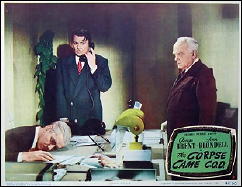
Lt. Wilson: You know its funny how you always happen to be on the scene whenever anyone is slugged or murdered.
How many times have we heard that one in one of these?
Frasso turns out to have a past with Mona Harrison and Hector Rose, and an iffy criminal record including some shady dealings in the jewelry racket.
Joe: Hot?
Mitchell Edwards: Let’s just say too cheap for my taste.
Back at Mona Harrison’s Rosemary gets to dope from her on her past marriage back in Denver while Joe examines the bolt of cloth she hid with a fortune in diamonds in it. Mona used to be married to a man who hates her now — maybe enough to frame her for murder, but she is too scared of him to say more.
Joe manages to lose the diamonds, but not before he figures out who done it, and closes in on the killer back at Mona Harrison’s place, about the least “least likely” suspect in the history of these things.
I’m not sure even Agatha Christie could have pulled this one off, but to be fair the clues are there if you look for them, which is more than many of these manage to do. Once you know who the killer is you can honestly look back and see where you had half a chance to figure it out if you were paying close attention.
The Corpse Came C.O.D. is no lost classic, but in the right mood it’s fast paced, fairly funny, and the mystery a bit better than average with some decent misdirection along the way.
I must say I found it generally more entertaining than I expected, and only wished the energy of the actors and the comedy had been as good as the mystery element — which is a unique complaint about a comedy-mystery from this era.
Tue 17 Aug 2010
Posted by Steve under
Reviews1 Comment
IT IS PURELY MY OPINION
Reviews by L. J. Roberts
JENNIFER LEE CARRELL – Haunt Me Still. Dutton, hardcover, April 2010; trade paperback reprint: Plume, February 2011. Published in the UK as The Shakespeare Curse, as by J. L. Carrell: Sphere, softcover, January 2010.

Genre: Amateur sleuth. Leading character: Kate Stanley; 2nd in series. Setting: Scotland.
First Sentence: Wrapped in a gown of blue-green velvet trimmed with gold, a queen’s crown on his head, the boy sat drowsing on the throne near the center of the Great Hall, just at the edge of the light.
Shakespeare scholar turned stage director Kate Stanley has been asked to meet Lady Nairn, formerly actress Janet Douglas. Lady Nairn wants Kate to direct a new production of the Scottish play incorporating the collection of valuable artifacts linked to the play collected by her late husband.
The play, and Shakespeare’s talent, has always been linked to the occult, including rumors of a still-existing first version of the play which includes actual magical spells. Theater, the occult, kidnapping and murder have Kate on the run to save another’s life as well as her own.
Ms. Carrell’s very compelling opening is set in 1606 and creates an immediate atmosphere of suspense. While most of the story takes place in the present, the scenes in the past provide historic detail important to the story.
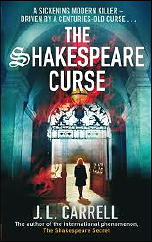
Ms. Carrell’s level of knowledge and research done on all the subjects is clear and appreciated. If anything, other than the protagonist, the details are inclined to overwhelm the characters. This would normally be a very big deal but here, I didn’t actually mind.
Her protagonist, Kate, is both someone you’d like to be, but not. She’s smart, tough and independent, but vulnerable and does have her own TSTL (too stupid to live) moment.
Each of the other characters was distinct enough never to be confusing. A couple of the secondary characters were ones to whom I felt particularly attached. For me, having that empathy is critical.
Ms. Carrell has a wonderful narrative voice with evocative descriptions — “…her face lined with the fine-china crackling of very fair skin in old age.” — which captivates and carries you off into the story.
Whether in the past or present, the scenes were wonderfully, sometimes gruesomely, visual. Carrell expertly walked that fine line between making the reader want to be there, and happy they were not.
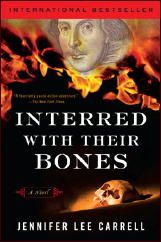
There is a Dan Brown-ish aspect to the plot in that the last part of the book is a race against time, looking for a secret item, but this felt more possible to me. Yes, there was one rather large hole in the plot and rather too many coincidences, but it was also suspenseful; exciting and fascinating with a huge edge-of-the-seat grip to it.
I’m not certain this book would appeal to everyone. Because it is so information focused, some might find the historical and non-character background slows the pace of the story. However, for those with some knowledge and love of English history, occult, mythology, Shakespeare, this is a very good, very exciting read.
Rating: Very Good Plus.
Editorial Comment: The first appearance of Kate Stanley, Interred with Their Bones (aka The Shakespeare Secret) was reviewed here on this blog by David Vineyard.
Mon 16 Aug 2010
Posted by Steve under
Reviews[4] Comments
REVIEWED BY BARRY GARDNER:
PETER LOVESEY – Diamond Solitaire. Mysterious Press, hardcover, 1993; reprint paperback, 1994. UK edition: Little Brown, hardcover, 1992. Trade paperback: Soho Press, 2002. Peter Diamond #2.
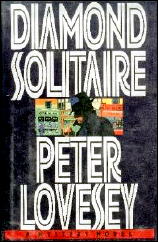
This is the second in the series begun with the very popular The Last Detective. I liked the first book, though not nearly so much as many did. To me, his best work remains the Cribb books, and then Bertie.
Peter Diamond, no longer a policeman since resigning in a huff at the end of the first book, now is a security guard for Harrod’s; at least until an alarm goes off in his section of the furniture department, and a young Japanese girl is found where she shouldn’t be.
Then he’s unemployed. He becomes concerned when no one has claimed the girl – who hasn’t spoken a word, and is feared to be autistic – several weeks later, and being more than a little bored, offers to try to bring her out of her shell.
Before it’s all done, his path has crossed Big American Business, he has been to America and Japan, and has been befriended by a legendary Sumo wrestler.
Let’s start off with the positives. Lovesey is a fine writer and storyteller. Rarely will anyone find fault with his prose or his pacing, and Solitaire is no exception. He’s unusually good with characters, too, and Diamond is a likeable one, particularly in his relationship with the young girl.
So what’s wrong, then? Well, it’s the plot, innit? It’s silly. Full of things that couldn’t happen/wouldn’t happen. (Send an SASE for a list.)
Diamond blusters and bulls his way around and things eventually work out, but I didn’t believe a word of it. Maybe that’s the kind of book he was trying to write, but I don’t think so. Certainly I don’t remember the first Diamond that way. Sorry, but I thought this was distinctly minor-league Lovesey.
— Reprinted from Ah, Sweet Mysteries #10, November 1993.
Previously reviewed on this blog —
Skeleton Hill (by Walter Albert)
Bloodhounds (by L. J. Roberts)
In both instances, considerable discussion — and some disagreement — broke out pertaining to the relative merits of Lovesey’s Peter Diamond series and his earlier historical mysteries.
Sun 15 Aug 2010
Marsha Hunt, the female co-star of Kid Glove Killer (1942), reviewed here by Walter Albert, and whose career was discussed at length in the comments that followed, is scheduled to make an appearance at this year’s Mid-Atlantic Nostalgia Convention.
Other guests include:
VAN WILLIAMS (Surfside 6, The Green Hornet)
ROY THINNES (The Invaders)
DAWN WELLS (Mary Ann on Gilligan’s Island)
MARK GODDARD (Johnny Ringo, Lost in Space)
GERI REISCHL (Jan Brady on The Brady Bunch Hour)
ED NELSON (Peyton Place and tons of TV and Roger Corman films)
WILL HUTCHINS (Sugarfoot, Hey Landlord, Blondie)
ON DISPLAY! The original 1966 Chrysler Imperial Black Beauty from the Green Hornet TV series! There were only two made and one of them resides in a museum in California. The other is owned by a private collector who fully restored the vehicle and will have it on display at the convention. (This is not a replica!)
For more information, check out the convention’s website here.
I wish I could be there, but perhaps you can. From all accounts, the convention is getting bigger and better every year.
Sun 15 Aug 2010
A TV Review by MIKE TOONEY:
“Dear Uncle George.” An episode of The Alfred Hitchcock Hour (Season 1, Episode 30). First air date: 10 May 1963. Gene Barry, John Larkin, Patricia Donahue, Dabney Coleman, Robert Sampson, Lou Jacobi. Teleplay: James Bridges. Story and teleplay: Richard Levinson and William Link. Director: Joseph M. Newman.
John Chambers (Gene Barry) writes an advice column for a local newspaper under the name Uncle George; of late, however, he has become disenchanted with his boss, Simon Aldritch (John Larkin), especially regarding Simon’s editorial decisions.
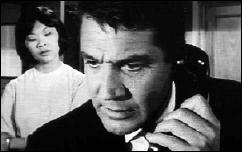
One day Chambers gets a letter, which he dismisses at first. Someone has been observing the goings on in an apartment complex across the way; the note says that it’s fairly obvious a married woman is seeing a man who is not her husband.
A hint here and a hint there and it’s not long before Chambers connects the dots: The unfaithful woman is his own wife, Louise (Patricia Donahue), and the man she’s seeing can only be his friend Tom Esterow (Dabney Coleman), an artist.
Chambers sees red, and like many a cuckolded husband in a 17th century revenge tragedy he impulsively and violently lashes out. There remains only one problem, however: In his own mind he has killed the “right” person, so justice demands the other malefactor should suffer as well.
Coolly and carefully he plants clues that will send the police after the other lover. Imagine Chambers’ surprise, though, when he discovers he’s framed the wrong person….
Once again Levinson & Link score big with a marvelously involved plot and even some character development in John Chambers (Barry), who is more complex than merely being the murderer; because, you see, despite being a killer, he nevertheless tries to do the right thing — with ironic results.
Since this an L & L prodduct, one may be forgiven for detecting one or two similarities between this story and Prescription: Murder (1968), the first Columbo film, in which Gene Barry also murders his wife; but in the latter production his cold and calculating premeditation contrasts with his crime of passion in “Dear Uncle George.”
Moreover, Lt. Wolfson (Lou Jacobi), the investigating officer, differs from Peter Falk’s character in being too willing to trust in prima facie evidence.
Gene Barry (1919-2009) died late last year. Some screen credits: The Atomic City (1952, his film debut), The War of the Worlds (1953, pursuing Martian vandals), Naked Alibi (1954), The Houston Story (1956), Hong Kong Confidential (1958), Thunder Road (1958), Istanbul Express (1968, TVM), Subterfuge (1968), a Perry Mason movie (1987, TVM); and the TV series Bat Masterson (1958-61), Burke’s Law (1963-66, 1994-95), The Name of the Game (1968-71), and The Adventurer (1972-73).
You can view “Dear Uncle George” on Hulu here.
Sun 15 Aug 2010
THE BACKWARD REVIEWER
William F. Deeck
CHRISTOPHER BUSH – Dead Man’s Music. Howard Baker, UK, hardcover reprint, 1970. First Edition: Wm. Heinemann, UK, hc, 1931. US hardcover: Doubleday Doran/Crime Club, 1932.

An odd request to Durangos, Limited, sends Ludovic Travers, newly appointed director, to Steyvenning, Sussex. Claude Rook is looking for a man of “implicitly honourable confidence” who knows china and music and is quick-witted.
When Travers more or less satisfies Rook’s requirements, Rook gives him a musical manuscript with unclear instructions what to do with it. As might have been guessed, Rook turns up dead, maybe having been tortured and maybe having committed suicide. One of the several odd things about his death is that someone shaved him shortly after he died
Who was Rook? Why did he give the musical manuscript to Travers? What did the manuscript mean, particularly since it is not the piece Rook played for Travers?
Not one of Travers’ better cases, more a thriller than a detective novel. A library patron — I deplore this tendency but must give the lady or gentleman credit for perceptivity– has scribbled on the cover, “Not good.”
Not bad, either, but certainly a surprisingly weak selection to reprint, considering all the first-class novels that Bush has produced.
— From The MYSTERY FANcier, Vol. 11, No. 2, Spring 1989.
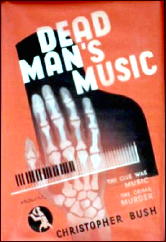
Bibliographic Data: If my count is correct, Dead Man’s Music is the 5th of 63 mysteries in which Ludovic Travers was the sleuth of record.
The first appeared in 1926, the last in 1968. Christopher Bush also wrote another dozen or so detective novels as by Michael Home in which Travers did not appear.
It isn’t clear in Bill’s review, perhaps, but Travers himself was a licensed (and therefore private) investigator, so unless I’m wrong about this, it’s strange that he’s not included in Kevin Burton Smith’s list of PIs on his Thrilling Detective website.
Three more of Bush’s mysteries are reviewed by Mike Grost on his Classic Crime and Detection website, where he suggests that alibis and stage trickery are often significant factors in his work.
Sun 15 Aug 2010
Posted by Steve under
Reviews[2] Comments
REVIEWED BY WALTER ALBERT:
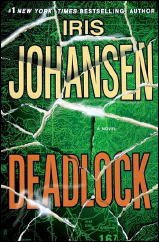
IRIS JOHANSEN – Deadlock. St. Martin’s, hardcover, April 2009; reprint paperback: October 2009.
There’s always at least one title in every bag of books I tote home from my local mystery bookshop that I can’t account for.
I drew a blank on this book until I read the back cover blurb that described the protagonist Emily Hudson as a “renowned archaeologist who travels the world to save priceless artifacts from theft or destruction.”
That was the hook that snared me.
I can report that I found the novel a quick read, leaving only the memory of a brief few moments of pleasure. This must be the ultimate example of escape reading, which slips away as soon as you’ve finished.
Sat 14 Aug 2010
Posted by Steve under
Reviews[4] Comments
GEORGE HARMON COXE – One Hour to Kill. Paperback reprint: Pyramid R-1186, May 1965. Hardcover edition: Alfred A. Knopf, 1963.
On the cover of the paperback that I have, it states that this was the author’s 50th mystery, so while I didn’t check that particular figure, I did go to look his record up in Hubin’s Crime Fiction III [the current edition at the time I wrote this review].
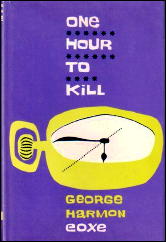
It takes a few years to write that many novels, and this one was written when the author was in his early 60s. Coxe went on to write another dozen or so more, averaging a book a year up until he was in his mid-70s. Earlier on he wrote for Black Mask and other pulp magazines of the 1930s, moved over to the slicks, and on the side, in his spare time, he did loads of work for radio, TV and the movies.
Very well known, and (one surmises) almost forgotten today. My own surmise depends on the other half of what I do when I’m not reading mysteries, and that’s selling them, and I’m sorry to say that George Harmon Coxe is not a big seller. Not a poor seller, I hasten to add, but well below average, and not proportional to his output as an author.
When I was a member of the Dollar Mystery Guild in the mid-to-late 50s, I devoured his books, but mostly the ones with either of the two Boston newspaper photographers, Flashgun Casey or Kent Murdock.
I couldn’t tell you why for sure, but I think the lure of a couple of guys who knew their way around a tough metropolitan area offered a considerable amount of appeal to a young boy growing up in upstate Michigan.
I didn’t care for his other mysteries very much, though, the ones taking place primarily in the islands of the Caribbean, of which this is a prime example, and in Trinidad, to be precise. Too foreign, to me, I think, at the time.
In any case, to get on with the story, in One Hour to Kill Dave Wallace is having marital problems. He has a new love in his life, but he also has a wife who’s just reneged on a divorce and has come down to move back in. (She also one of the most unpleasant women I come across in quite a bit of reading, if I may offer a brief aside.)
When she’s murdered, as it quite evident she will be within the first two pages of meeting her, Wallace knows he’s the obvious first person the police will suspect, and he decides he has to keep two jumps ahead of them to clear himself, concealing evidence, picking up clues, and generally muddying up the trail.
All pretty much the wrong decisions to make — the native policemen are not dummies — but then again, if he didn’t, we probably wouldn’t have a story.
And as it turns out, it’s through his efforts that the crime is solved — a fair-play story of detection — so fair, in fact, that when the truth is revealed, you can see where Coxe practically gave the game completely away, if you were paying attention, and as usual, my mind was elsewhere at the time.
Some of the ways that Wallace uncovers information are so patently artificial, however, that it’s — and here comes my excuse — it’s difficult to concentrate on what really matters.
Here’s a bit of what I mean. On page 94 Wallace is talking to someone who says, “There was one other thing, now that I think of it.” This is someone who is on Wallace’s side and not only was there one more thing, but he eventually ends up confiding in him that (a) he was eavesdropping on the dead woman before she died, (b) overheard the tail end of a crucial telephone conversation, (c) saw another car drive up, and (d) wrote down the license number. No less.
Coxe is a very precise writer in most ways, with well-constructed backgrounds for all of the characters, and lots of descriptions of homes, offices and (to be expected) taverns, restaurants and other watering holes on the island.
But while the timing of events surrounding the murder is really quite cleverly done — see the title of the book — Coxe’s tale also seems to have become outdated in a way he didn’t quite foresee. The final clue, in fact, the one that points to the killer, is therefore one I can’t tell you very much about, but here’s a hint.
Maybe, just maybe, back in the era when you had to step on starters to get cars going, maybe a crucial switch that killer had to make could have been done, and no one would have thought anything about it.
Today it seems as outmoded as (say) reading books on paper may be someday soon.
— July 2003 (slightly revised)
[UPDATE] 08-14-10. The revision comes in the last paragraph of this review, in which I used an updated example.
Previously on this blog:
Uninvited Guest (reviewed by Steve Lewis)
Old Time Radio: Crime Photographer [09 Nov 1950] “Woman of Mystery”
Murder for Two (reviewed by Steve Lewis)
Film: Here’s Flash Casey (reviewed by Steve Lewis)
GEORGE HARMON COXE in the Movies and on TV (by Tise Vahimagi)
Fashioned for Murder (reviewed by Steve Lewis)
Focus on Murder (reviewed by Steve Lewis)
[UH-OH DEPARTMENT.] I’ve just discovered that this is the second time I’ve posted this review — the first time was on Wednesday 6 Aug 2008, to be precise. Well, that was over two years ago. You can’t expect me to remember anything longer than that, can you?
I might have deleted this post after I found this out, but after doing all of the work it took to come up with all of George Harmon Coxe’s previous appearances on this blog, I wasn’t about to throw it all away.
But if you’d like a refund on this rerun, the line forms at the exit door, over there in the rear on the right.
« Previous Page — Next Page »
